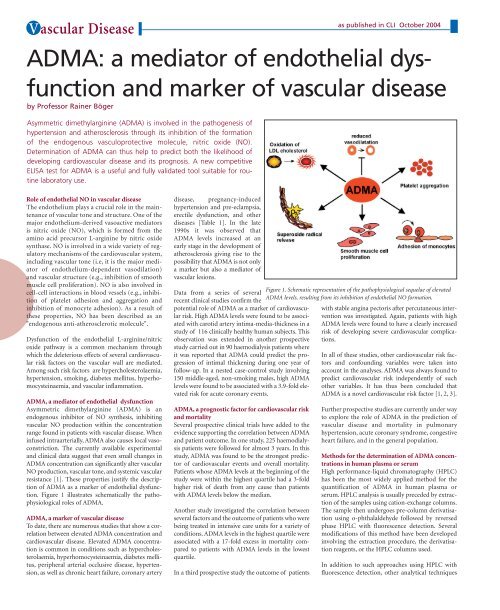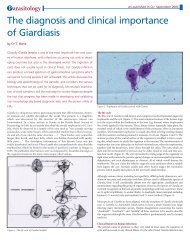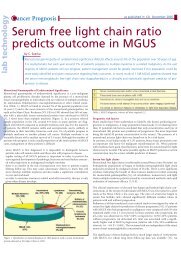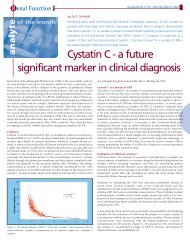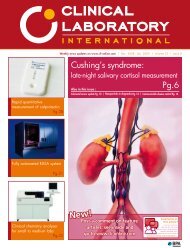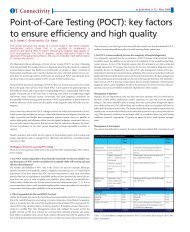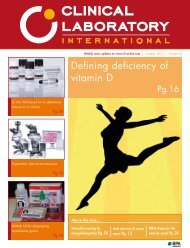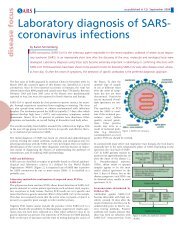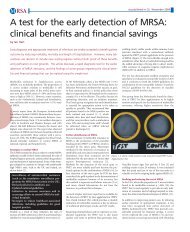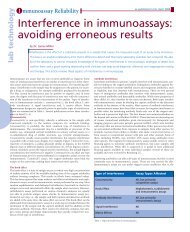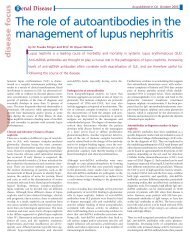ADMA: a mediator of endothelial dysfunction and marker of vascular ...
ADMA: a mediator of endothelial dysfunction and marker of vascular ...
ADMA: a mediator of endothelial dysfunction and marker of vascular ...
Create successful ePaper yourself
Turn your PDF publications into a flip-book with our unique Google optimized e-Paper software.
V ascular Disease<br />
as published in CLI October 2004<br />
<strong>ADMA</strong>: a <strong>mediator</strong> <strong>of</strong> <strong>endothelial</strong> <strong>dysfunction</strong><br />
<strong>and</strong> <strong>marker</strong> <strong>of</strong> <strong>vascular</strong> disease<br />
by Pr<strong>of</strong>essor Rainer Böger<br />
Asymmetric dimethylarginine (<strong>ADMA</strong>) is involved in the pathogenesis <strong>of</strong><br />
hypertension <strong>and</strong> atherosclerosis through its inhibition <strong>of</strong> the formation<br />
<strong>of</strong> the endogenous vasculoprotective molecule, nitric oxide (NO).<br />
Determination <strong>of</strong> <strong>ADMA</strong> can thus help to predict both the likelihood <strong>of</strong><br />
developing cardio<strong>vascular</strong> disease <strong>and</strong> its prognosis. A new competitive<br />
ELISA test for <strong>ADMA</strong> is a useful <strong>and</strong> fully validated tool suitable for routine<br />
laboratory use.<br />
Role <strong>of</strong> <strong>endothelial</strong> NO in <strong>vascular</strong> disease<br />
The endothelium plays a crucial role in the maintenance<br />
<strong>of</strong> <strong>vascular</strong> tone <strong>and</strong> structure. One <strong>of</strong> the<br />
major endothelium-derived vasoactive <strong>mediator</strong>s<br />
is nitric oxide (NO), which is formed from the<br />
amino acid precursor L-arginine by nitric oxide<br />
synthase. NO is involved in a wide variety <strong>of</strong> regulatory<br />
mechanisms <strong>of</strong> the cardio<strong>vascular</strong> system,<br />
including <strong>vascular</strong> tone (i.e, it is the major <strong>mediator</strong><br />
<strong>of</strong> endothelium-dependent vasodilation)<br />
<strong>and</strong> <strong>vascular</strong> structure (e.g., inhibition <strong>of</strong> smooth<br />
muscle cell proliferation). NO is also involved in<br />
cell-cell interactions in blood vessels (e.g., inhibition<br />
<strong>of</strong> platelet adhesion <strong>and</strong> aggregation <strong>and</strong><br />
inhibition <strong>of</strong> monocyte adhesion). As a result <strong>of</strong><br />
these properties, NO has been described as an<br />
"endogenous anti-atherosclerotic molecule".<br />
Dysfunction <strong>of</strong> the <strong>endothelial</strong> L-arginine/nitric<br />
oxide pathway is a common mechanism through<br />
which the deleterious effects <strong>of</strong> several cardio<strong>vascular</strong><br />
risk factors on the <strong>vascular</strong> wall are mediated.<br />
Among such risk factors are hypercholesterolaemia,<br />
hypertension, smoking, diabetes mellitus, hyperhomocysteinaemia,<br />
<strong>and</strong> <strong>vascular</strong> inflammation.<br />
<strong>ADMA</strong>, a <strong>mediator</strong> <strong>of</strong> <strong>endothelial</strong> <strong>dysfunction</strong><br />
Asymmetric dimethylarginine (<strong>ADMA</strong>) is an<br />
endogenous inhibitor <strong>of</strong> NO synthesis, inhibiting<br />
<strong>vascular</strong> NO production within the concentration<br />
range found in patients with <strong>vascular</strong> disease. When<br />
infused intraarterially, <strong>ADMA</strong> also causes local vasoconstriction.<br />
The currently available experimental<br />
<strong>and</strong> clinical data suggest that even small changes in<br />
<strong>ADMA</strong> concentration can significantly alter <strong>vascular</strong><br />
NO production, <strong>vascular</strong> tone, <strong>and</strong> systemic <strong>vascular</strong><br />
resistance [1]. These properties justify the description<br />
<strong>of</strong> <strong>ADMA</strong> as a <strong>marker</strong> <strong>of</strong> <strong>endothelial</strong> <strong>dysfunction</strong>.<br />
Figure 1 illustrates schematically the pathophysiological<br />
roles <strong>of</strong> <strong>ADMA</strong>.<br />
<strong>ADMA</strong>, a <strong>marker</strong> <strong>of</strong> <strong>vascular</strong> disease<br />
To date, there are numerous studies that show a correlation<br />
between elevated <strong>ADMA</strong> concentration <strong>and</strong><br />
cardio<strong>vascular</strong> disease. Elevated <strong>ADMA</strong> concentration<br />
is common in conditions such as hypercholesterolaemia,<br />
hyperhomocysteinaemia, diabetes mellitus,<br />
peripheral arterial occlusive disease, hypertension,<br />
as well as chronic heart failure, coronary artery<br />
disease, pregnancy-induced<br />
hypertension <strong>and</strong> pre-eclampsia,<br />
erectile <strong>dysfunction</strong>, <strong>and</strong> other<br />
diseases [Table 1]. In the late<br />
1990s it was observed that<br />
<strong>ADMA</strong> levels increased at an<br />
early stage in the development <strong>of</strong><br />
atherosclerosis giving rise to the<br />
possibility that <strong>ADMA</strong> is not only<br />
a <strong>marker</strong> but also a <strong>mediator</strong> <strong>of</strong><br />
<strong>vascular</strong> lesions.<br />
Data from a series <strong>of</strong> several<br />
recent clinical studies confirm the<br />
potential role <strong>of</strong> <strong>ADMA</strong> as a <strong>marker</strong> <strong>of</strong> cardio<strong>vascular</strong><br />
risk. High <strong>ADMA</strong> levels were found to be associated<br />
with carotid artery intima-media-thickness in a<br />
study <strong>of</strong> 116 clinically healthy human subjects. This<br />
observation was extended in another prospective<br />
study carried out in 90 haemodialysis patients where<br />
it was reported that <strong>ADMA</strong> could predict the progression<br />
<strong>of</strong> intimal thickening during one year <strong>of</strong><br />
follow-up. In a nested case-control study involving<br />
150 middle-aged, non-smoking males, high <strong>ADMA</strong><br />
levels were found to be associated with a 3.9-fold elevated<br />
risk for acute coronary events.<br />
<strong>ADMA</strong>, a prognostic factor for cardio<strong>vascular</strong> risk<br />
<strong>and</strong> mortality<br />
Several prospective clinical trials have added to the<br />
evidence supporting the correlation between <strong>ADMA</strong><br />
<strong>and</strong> patient outcome. In one study, 225 haemodialysis<br />
patients were followed for almost 3 years. In this<br />
study, <strong>ADMA</strong> was found to be the strongest predictor<br />
<strong>of</strong> cardio<strong>vascular</strong> events <strong>and</strong> overall mortality.<br />
Patients whose <strong>ADMA</strong> levels at the beginning <strong>of</strong> the<br />
study were within the highest quartile had a 3-fold<br />
higher risk <strong>of</strong> death from any cause than patients<br />
with <strong>ADMA</strong> levels below the median.<br />
Another study investigated the correlation between<br />
several factors <strong>and</strong> the outcome <strong>of</strong> patients who were<br />
being treated in intensive care units for a variety <strong>of</strong><br />
conditions. <strong>ADMA</strong> levels in the highest quartile were<br />
associated with a 17-fold excess in mortality compared<br />
to patients with <strong>ADMA</strong> levels in the lowest<br />
quartile.<br />
In a third prospective study the outcome <strong>of</strong> patients<br />
Figure 1. Schematic representation <strong>of</strong> the pathophysiological sequelae <strong>of</strong> elevated<br />
<strong>ADMA</strong> levels, resulting from its inhibition <strong>of</strong> <strong>endothelial</strong> NO formation.<br />
with stable angina pectoris after percutaneous intervention<br />
was investigated. Again, patients with high<br />
<strong>ADMA</strong> levels were found to have a clearly increased<br />
risk <strong>of</strong> developing severe cardio<strong>vascular</strong> complications.<br />
In all <strong>of</strong> these studies, other cardio<strong>vascular</strong> risk factors<br />
<strong>and</strong> confounding variables were taken into<br />
account in the analyses. <strong>ADMA</strong> was always found to<br />
predict cardio<strong>vascular</strong> risk independently <strong>of</strong> such<br />
other variables. It has thus been concluded that<br />
<strong>ADMA</strong> is a novel cardio<strong>vascular</strong> risk factor [1, 2, 3].<br />
Further prospective studies are currently under way<br />
to explore the role <strong>of</strong> <strong>ADMA</strong> in the prediction <strong>of</strong><br />
<strong>vascular</strong> disease <strong>and</strong> mortality in pulmonary<br />
hypertension, acute coronary syndrome, congestive<br />
heart failure, <strong>and</strong> in the general population.<br />
Methods for the determination <strong>of</strong> <strong>ADMA</strong> concentrations<br />
in human plasma or serum<br />
High performance-liquid chromatography (HPLC)<br />
has been the most widely applied method for the<br />
quantification <strong>of</strong> <strong>ADMA</strong> in human plasma or<br />
serum. HPLC analysis is usually preceded by extraction<br />
<strong>of</strong> the samples using cation-exchange columns.<br />
The sample then undergoes pre-column derivatisation<br />
using o-phthalaldehyde followed by reversed<br />
phase HPLC with fluorescence detection. Several<br />
modifications <strong>of</strong> this method have been developed<br />
involving the extraction procedure, the derivatisation<br />
reagents, or the HPLC columns used.<br />
In addition to such approaches using HPLC with<br />
fluorescence detection, other analytical techniques
V ascular Disease<br />
as published in CLI October 2004<br />
pathway. Arterioscler Thromb Vasc Biol 2004; 24: 1023-<br />
1030.<br />
3. Cooke JP. Asymmetrical dimethylarginine: the Über<br />
<strong>marker</strong>? Circulation 2004; 109: 813-818.<br />
4. Schulze F, Wesemann R, Schwedhelm E, Sydow K,<br />
Albsmeier J, Cooke JP, Böger RH. Determination <strong>of</strong><br />
<strong>ADMA</strong> using a novel ELISA assay. Clin Chem Lab Med<br />
2004; in press.<br />
The author<br />
Rainer H. Böger, MD<br />
Pr<strong>of</strong>essor <strong>and</strong> Head, Clinical Pharmacology Unit<br />
Institute <strong>of</strong> Experimental <strong>and</strong> Clinical Pharmacology<br />
University Hospital Hamburg-Eppendorf, Germany<br />
Table 1. Diseases that are associated with elevated <strong>ADMA</strong> levels. Data in row 2 indicate -fold increase in <strong>ADMA</strong> levels in<br />
the conditions specified in row 1, as assessed in cross-sectional studies. Data in row 3 indicate -fold increase in risk with<br />
elevated <strong>ADMA</strong> as compared to patients with low <strong>ADMA</strong> as assessed in prospective clinical studies.<br />
have been used. These include capillary electrophoresis,<br />
liquid chromatography - t<strong>and</strong>em mass<br />
spectrometry (LC-t<strong>and</strong>em MS), <strong>and</strong> gas chromatography<br />
- t<strong>and</strong>em mass spectrometry (GC-t<strong>and</strong>em<br />
MS). All <strong>of</strong> these methods are laborious, frequently<br />
unavailable in many laboratories, <strong>and</strong> generally<br />
not applicable for routine diagnostic use.<br />
We recently developed <strong>and</strong> validated an <strong>ADMA</strong><br />
ELISA assay based on the principle <strong>of</strong> competitive<br />
immunoassay for the determination <strong>of</strong> <strong>ADMA</strong> levels<br />
in serum, plasma <strong>and</strong> other biological fluids. In<br />
contrast to the other methods for measuring<br />
<strong>ADMA</strong>, the new ELISA test is easy to carry out <strong>and</strong><br />
can be used as a high throughput method. The combination<br />
<strong>of</strong> an acylation step <strong>and</strong> the competitive<br />
principle <strong>of</strong> the ELISA tests has resulted in a specific,<br />
highly sensitive <strong>and</strong> non isotopic immunoassay.<br />
The antiserum used in the assay is specific for<br />
<strong>ADMA</strong> <strong>and</strong> shows negligible cross reactivities with<br />
L-arginine (


